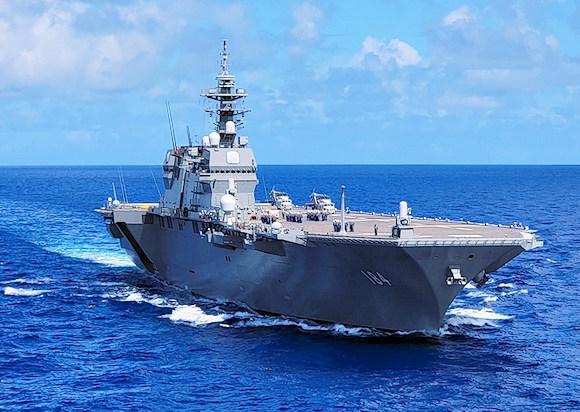Abe Shinzō, the most prominent Japanese prime minister in over 60 years, has given impetus and defined features to Tokyo's foreign and defense policy; the strategic evolutions induced by the post-Cold War, with Abe find a concrete institutionalization, aiming to elevate Japan in the international arena, making it abandon the posture ofinward-looking: Yoshida Doctrine, and projecting it towards a strategic model worthy of a political entity with capabilities commensurate with its economic caliber.
It is in this context that both the deepening of relations with the USA and the re-reading of article 9 of the Constitution find space, aimed at allowing the exercise of the right of collective self-defense.
In this dimension we can better frame the diversification of Indo-Pacific relations, such as those between India and Australia which, with Tokyo and Washington, make up the Quad, in accordance with the vision of an Indo Pacific free and open.
Attention to the first implications of foreign policy: while the US supports the new military posture, China, North and South Korea criticize, and Israel sees opportunities to sell missile defense systems, UAVs and cyber control, not to mention the intelligence aimed at Pyongyang and its cooperation nuclear with Iran; to this add theaxis with London1 and the Italian Leonardo for participation in the program Tempest, with the development of a new fighter-bomber model expected to enter service in 2035.
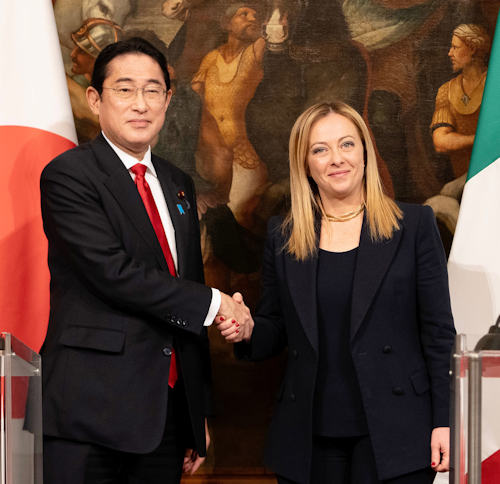 With the end of the anti-Covid restrictions, Prime Minister Kishida, in a short time, traveled to 19 countries either on a state visit or for international summits, outlining the priorities of the Japanese government, I learn to emerging powers, consolidating relations with more traditional partners, taking care of multilateralism and the creation of alternative strategic axes.
With the end of the anti-Covid restrictions, Prime Minister Kishida, in a short time, traveled to 19 countries either on a state visit or for international summits, outlining the priorities of the Japanese government, I learn to emerging powers, consolidating relations with more traditional partners, taking care of multilateralism and the creation of alternative strategic axes.
These aspects cannot but lead back to theabenomics2, the administrative base in the broadest sense of the executives chaired by Abe, who intended to involve Tokyo in the various regional trade, multilateral and free trade initiatives3, aiming at the creation of production chains placed outside the sphere of influence of the Chinese antagonists.
Abe's vision has become the baton passed to premier Kishida who, confronted with demographic decline, price fluctuations, wage depression, aggressive competition from Beijing, must adapt the previous political legacy to very rapid and contingent changes.
The constraint of maintaining military expenditure within 1% of GDP was lifted with the decision to increase them to 2%4 within five years, an increase which, financed with higher taxation, would give Japan the bronze medal5 after USA and China6; the goal of 2% of GDP to be reached by the end of 2028 also aligns Japan with NATO spending standards, with which Tokyo is establishing closer relations.
As far as the security aspect is concerned, the three strategic documents approved by the Kishida government hold the ground: the new one National Security Strategy (NSS)7, which by including the inseparable link between economy and security, replaces that of 2013 targata Abe; there National Defense Strategy (NDS) (formerly known as the National Defense Program Guidelines) and the Defense Buildup Program (DBP) (formerly Medium-Term Defense Program), for which international uncertainty can only accelerate investments in the defensive field, reaching a balance between external risks and internal political consensus8, to which the law for the promotion of economic security, aimed at protecting infrastructures, reducing the degree of dependence on other countries, avoiding pressure from abroad.
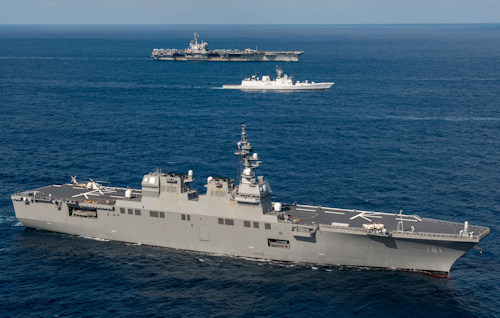 What is certain is that in the military sphere Abe has accentuated Japanese autonomy with respect to the alliance with the United States, which has outlined a silhouette of a more proactive subject on the international stage.
What is certain is that in the military sphere Abe has accentuated Japanese autonomy with respect to the alliance with the United States, which has outlined a silhouette of a more proactive subject on the international stage.
La reinterpretation of the art. 9 of the Constitution9, which prohibits Japan from having its own army by not recognizing it any right of belligerence, would therefore legitimize the military presence in the metropolitan area and, at the same time, the greater collaboration with the US forces stationed in the Pacific, attentive to the military-political evolutions in the Taiwan Strait .
The Constitution modeled by General MacArthur has allowed a compromise solution, namely the creation of paramilitary forces forming part of the police force, but equipped with everything an armed force may need; the paradox lies in the fact that the idea would never have occurred to the American occupiers that Japanese disarmament could be questioned precisely by Washington. After all, no one could have foreseen that Tokyo's economic boom would find one of his motivations precisely in that article which, written to prevent rearmament, became a weapon to guarantee security and economic stability.
Abe aside, the reform project took shape in August 2005 with premier Koizumi Junichirō who proposed, without success, to include in article 9 the explicit mention of Self-Defense Forces (SDF) giving them the possibility to defend their territory and who announced Japanese support for the American intervention in Afghanistan, which was followed by several other humanitarian missions10, an aspect which has facilitated the overcoming of the impeding constitutional interpretations, but which has underlined how the Japanese military role has become increasingly active also in the light of a revision of the concept of legitimate defense.
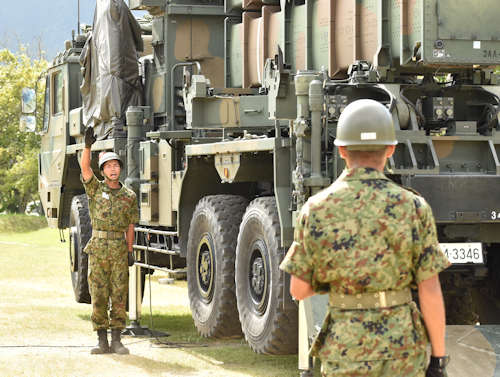 The role covered by the organization is significant Nippon Kaigi which, strong in the membership of prominent political personalities, has become the interpreter of a sort of revival of the Japanese imperial legacy which, however, it must not lead to confusion of rearmament with re-militarization.
The role covered by the organization is significant Nippon Kaigi which, strong in the membership of prominent political personalities, has become the interpreter of a sort of revival of the Japanese imperial legacy which, however, it must not lead to confusion of rearmament with re-militarization.
Abe's reformism has not led to a return to growth in a vulnerable economy, despite the devaluation useful for an increase in exports.
Politically, the activism of Abe first and Kishida now is a reaction to the relative Japanese decline in the Asia-Pacific area, due to several causes: the Chinese maritime assertiveness which, in addition to the creation of artificial islands and oil drilling, questions the issues of sovereignty and territorial integrity of the Senkaku/Diàoyú Islands; the looming Russian presence; the economic and technological advancement of South Korea; the nuclear threat from Pyongyang; the growth of regional middle powers; the emergence of jihadist terrorism as a force capable of transforming itself into a state and of kidnapping and killing Japanese hostages. Japan's growing strategic role in the Pacific fits into the context of the delegation given by the Americans to its regional allies, aimed at countering Chinese expansionism intent on assuring control of supply lines thanks to greater militarization of the countries in the area, also in light of North Korea's nuclear capabilities.
By history, geographical position and degree of development, Japan embodies the role of the ideal candidate in the maritime sector for a strategic partnership with the USA. In fact, the Asian context has led Tokyo to gradually abandon its own institutional pacifism, the shield which, with the US defensive umbrella, has converted the original expansionist drive into absolute dedication to corporate work; however, as has already happened throughout its history, the evolution of the geopolitical context is pushing Japan to change its foreign policy.
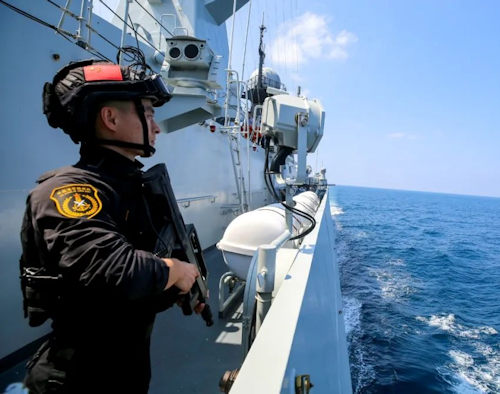 The exogenous element that has upset the balance is China, with its apparently unstoppable economic growth, accompanied by an increasingly less conciliatory geopolitical posture and increasingly distant from the concept of peaceful growth. Inevitable, in 2014, the new interpretation official of Article 9, according to which Tokyo could have used its own Self-Defense Forces, in fact a real Army, to participate in the collective defense system recognized by international law. If the country's full rearmament is no longer illegitimate, it will still be difficult to overcome the procedural constraints of constitutional changes; the preparation of the new aircraft carrier Kaga11 (photo), which bears the same name as the unit that attacked Pearl Harborconstitutes a sign of rapprochement with an exclusive military sovereignty.
The exogenous element that has upset the balance is China, with its apparently unstoppable economic growth, accompanied by an increasingly less conciliatory geopolitical posture and increasingly distant from the concept of peaceful growth. Inevitable, in 2014, the new interpretation official of Article 9, according to which Tokyo could have used its own Self-Defense Forces, in fact a real Army, to participate in the collective defense system recognized by international law. If the country's full rearmament is no longer illegitimate, it will still be difficult to overcome the procedural constraints of constitutional changes; the preparation of the new aircraft carrier Kaga11 (photo), which bears the same name as the unit that attacked Pearl Harborconstitutes a sign of rapprochement with an exclusive military sovereignty.
It is appropriate to recall how the concept of Indo-Pacific was born in the early years of the century precisely as a Japanese strategic theory12 enunciated by Abe in a speech to the Indian Parliament, aimed at compensating for Chinese regional influence and drawing attention to the importance of free navigation and free movement of trade; hence the identification of the main players in the area: Japan, Australia, India, to which were added the USA: to the QUAD13 this was followed by the expansion of the Japanese range of action towards all those countries concerned by Chinese growth thanks to the FOIP14, as opposed to Belt and Road Initiative. But the Japanese strategy is not limited to the economic sphere, it also extends to the military one, a trend that has strengthened with Abe, voted to amend the Constitution, also strong in the opinion polls according to which 65% of Japanese thought it necessary to update the Fundamental card. In any case, Abe's assassination did not stop the debate, although the removal of constitutional constraints remains a question awaiting a solution, in light of the need to strengthen defenses, a point made sensitive by the Ukrainian invasion thanks to the renewed perception of the threat which led to consider the possibility for the SDF to receive formal legal recognition and to acquire the ability to attack enemy missile bases.
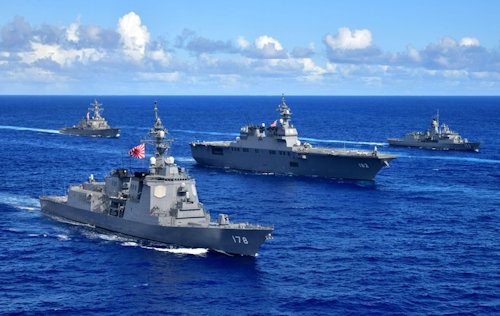 Over the years Japan, after having established a real Ministry of Defense, has pursued constant naval development, arriving at having one of the first world navies after the American one.
Over the years Japan, after having established a real Ministry of Defense, has pursued constant naval development, arriving at having one of the first world navies after the American one.
Taking into account that the Japanese strategic capacity has evolved since the beginning of the new century, the Chinese assertiveness in the South China Sea and the defense of the EEZs, which Tokyo wants to fix on the middle line, and Beijing according to the rule of 200 nautical miles, which would result in the Okinawa islands enjoying just 20 miles of territorial waters.
As with any maritime nation, Japanese interests rest on two fundamental foundations: the protection of communication lines15 and compliance with the law16, given the huge oil trade, a sensitive point for an economy which, after the Fukushima disaster, increasingly depends on energy imports. And this is where it comes into play Japan Maritime Self Defense Force equipped with an up-to-date and operational fleet, supported by aircraft, with over 50.000 men and women; in addition to the entry into service of the aircraft carriers Izumo17 250 meters long and weighing over 27.000 tons, it should be considered the strength of destroyers, the true backbone of the Japanese Navy. THE destroyers, with displacements ranging from 4.000 to over 10.000 tons, give substance to a strategy that aims at sea control in the Northern Pacific and in the seas adjacent to the islands of the national archipelago.
Therefore, the new strategy of the Ministry of Defense should be considered, which has given up the Aegis Ashore land positions, to increase the Aegis fighters, with the construction of new generation frigates (30FFM), to replace the older units, the Abukuma and the Asagiri. As of early 2020, the Japanese Navy had 48 fighters18, units equipped with weapons suitable for controlling and interdicting the airspace, guaranteeing protection from missile attacks.
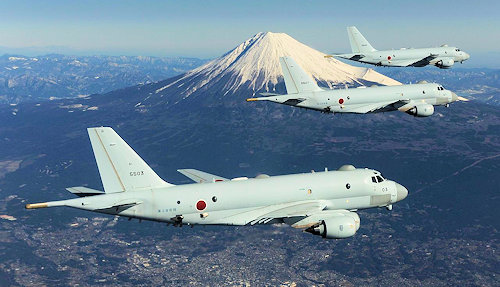 The role assigned to the fleet of maritime patrol vessels that take up the concept of the Air-Sea Battle American, in order to share data from multiple platforms allowing attacks from different and intercommunicating sources.
The role assigned to the fleet of maritime patrol vessels that take up the concept of the Air-Sea Battle American, in order to share data from multiple platforms allowing attacks from different and intercommunicating sources.
Japan also thus came to the concept of Multidimensional Joint Defense Force, for which the idea of integration between the armed forces, accelerated by Chinese geopolitics, has become fundamental; space control has also become exercisable by operational ships that interact with satellite communication, navigation and electronic warfare-support-intelligence19. Thus, today's warships have achieved battlefield integration, and are ready to face multidimensional warfare.
Le Izumo they were originally equipped with neither catapults nor lo ski-jump for short take-off; with the ongoing modifications they will be able to carry the short take-off and vertical landing variant of the F-35; meanwhile Tokyo has already procured 42 F-35A, conventional take-off and landing variant. The flight deck is in the process of being covered with a special heat-resistant material to withstand the temperatures of the flows generated by the JSF's short take-off. The entire short- and medium-range defensive grid will be reconfigured to facilitate F-35B flight operations, and the internal structure will be revised to accommodate the logistics line.
La Izumo completed the first of two modifications in 2021, and performed the first F35-B takeoff and landing demonstration test by USMC aircraft; the second modification should take place in 2025, with the rectangular modification of the bow. Japanese naval power is resurgent, and fighters are a real power factor. Chinese development and Korean aggressiveness have led to the need to have means capable of dealing with any type of threat; hence the production en casa of heavier and more performing vehicles20.
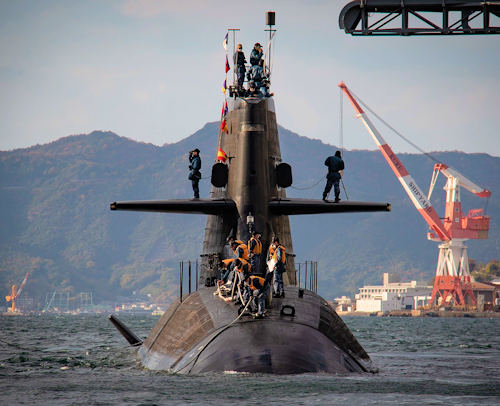 In addition to its surface strength, Japan can boast an expanding underwater component21, of at least 17 boats that have shown a technological capacity now capable of operating autonomously22.
In addition to its surface strength, Japan can boast an expanding underwater component21, of at least 17 boats that have shown a technological capacity now capable of operating autonomously22.
Japan has only one air base in Okinawa, Naha Air Base, the only structure to defend the entire southern area; having aircraft carriers, Tokyo could disperse the air force no longer tied to fixed structures, the inevitable primary target.
It is no coincidence that Tokyo has begun to build a base on the island of Mageshima, in the south-western prefecture of Kagoshima, useful for strengthening the defenses in the Ryukyu islands and for providing a reserve air base in the event of an attack on Okinawa; as a result of its position, Mageshima has become the ideal place for the landing of aircraft from American aircraft carriers, currently directed to Iwojima.
As reported by Asia Times Mageshima's strategic importance comes from the fact that, however small, it can serve as a logistics base, protective barrier, base of operations, geographic marker for maritime claims23.
How could a hypothetical Sino-Japanese military action develop? The Chinese ships would presumably engage the Japanese at different points to prevent them from concentrating in areas of amphibious landing activity south of the Ryukyus, and then aiming for a stable occupation; however, it must be taken into account that the dispersion of the units does not consider either the control of the airspace or how it affects maritime activities, which are limited in freedom of movement.
The Japanese anti-ship, aeronautical and air-naval capabilities make an action deep in the waters controlled by Tokyo risky, since it would expose ground-based aircraft to risks; as risky as the idea of committing entire naval battlegroups. Given the presence of Japanese garrisons on the Ryukyus24, the Chinese invasion forces are likely to face the consequences of phase-down strategy25, aimed at inflicting heavy losses.
 Finally, the strategy of the distributed lethality aimed at ensuring an increase in maritime power by increasing the offensive capabilities of each individual surface unit, littoral combat ship, amphibious ships26 (destined to become light aircraft carriers equipped with F-35Bs) and logistics included; units should form SAG groups27 small and scattered, difficult to hit according to a ratio that will also concern air and naval bases such as Guam with the rotation of aircraft, which would lead a possible invader to disperse its firepower as already happened between 41 and 45 in the Pacific .
Finally, the strategy of the distributed lethality aimed at ensuring an increase in maritime power by increasing the offensive capabilities of each individual surface unit, littoral combat ship, amphibious ships26 (destined to become light aircraft carriers equipped with F-35Bs) and logistics included; units should form SAG groups27 small and scattered, difficult to hit according to a ratio that will also concern air and naval bases such as Guam with the rotation of aircraft, which would lead a possible invader to disperse its firepower as already happened between 41 and 45 in the Pacific .
Is it an adequate strategy? The actual Chinese naval capacity should be considered, characterized by the prevalence of frigates over fighters, not all of which are advanced. Increased LCS operation would result in an advantage that could match the action of Chinese frigates by freeing up fighters for action.
Conclusions. Given politics and globalization, even in Japan the Ukrainian invasion has generated both a fear of a logistical vacuum and the need to reconsider the uncertainties based on an American defensive intervention in the event of a conflict with Russia or China, or a Chinese attack on Taiwan; given Western politics, inevitably, the collapse of the constitutional and pacifist convictions of a country that had to take note of the lack of an effective deterrent capacity or, better to say, of counterattack28, given the purely defensive nature of its armed forces which may still find themselves involved in a conflict with shared American nuclear weapons.
Tokyo had to take note of both the end of the rules of the international order in force, and the possible difficulties of maintaining the safety of maritime communication routes, especially in the absence of regional and global alliances. Extending the concept, it can be assumed that Japan intends to move from passive to active pacifism.

Politically, Japan is claiming its central role in achieving and maintaining a new regional and global equilibrium, assuming a prominent position in the global supply chain. At the moment, as is often the case, the weakness of the EU stands out.
A mistake to avoid, however, is to consider only the major contenders, the USA and China, committed to giving substance to theirs Thucydides' trap, without assessing the presence of the other players, i.e. Japan, India, Vietnam, the Philippines, Indonesia, Australia, committed to countering the arbitrary nine dash lines Chinese.
From a naval point of view, Indian air-naval power will play a significant role in containing China, in function of the alliance with Tokyo, the other arm of the pincer that would grip Beijing, conditioned by a concept of maritime power still influenced by continental visions; British and Japanese, not surprisingly, have shown that smaller fleets guided by a clear and sharp strategy often prevail over larger fleets but not equal in training.

1 Last January Rishi Sunak and Fumio Kishida announced the achievement of a military cooperation agreement in the process of being approved; agreement that expresses a common geopolitical vision on the Far East. To this must be added the Japanese intent to access the Five Eyes.
2 The context must be assessed in the light of the Asian crisis of 1997 and the Dot-Com bubble of 2001, which brought Japan into a recession and into a situation theorized by Keynes: the liquidity trap. As a result of negative expectations Japan hoarded liquidity rather than spending; without demand for goods, the recession started with an increase in unemployment and lower consumption and investments. Japan returned to growth in the years following Fukushima and political instability was set aside by the leadership of Shinzo Abe's government.
3 Comprehensive and Progressive Trans-Pacific Partnership; EU-Japan Economic Partnership Agreement; Regional Comprehensive Economic Partnership.
4 This is not a doubling tout court; some expenses had already been considered under other headings
5 See Enhancement of cybersecurity and long-range precision missiles. Tokyo is developing the capacity of stand-off, i.e. the ability to respond to threats in the sea and in the airspace. From a limited range of about 125 miles, it has moved to a range of over 300, with the intention of introducing missiles with a range of 1.000 miles.
6 Despite the profuse commitment to US support in Asia-Pacific, Tokyo has kept diplomatic channels open with Beijing, which is currently among the top trading partners; meanwhile Washington, with theIndo-Pacific Economic Framework for Prosperity (Ipef) of 2022, attempts to induce allies/partners to decouple their economies from that of China.
7 The NSS identifies China and North Korea's activities as an unprecedented strategic challenge and serious and imminent threat. Also note that Russia's aggression against Ukraine has easily violated the very foundations of the rules that shape the international order; the NDS establishes that the Russian aggression was possible because Ukraine's defense capability was insufficient to generate deterrence
8 The new lines have developed a concept based on dynamic defense and deterrence with an improvement in the effectiveness of intelligence and reconnaissance activities.
9 The article appears penalizing for a sovereign nation, as well as being the subject of discussion from a juridical point of view. The text is presented as a binding and enforceable norm in the ambit of national policy. Perplexities arose immediately both for the denial of legitimate defense and for the compatibility of the article with the collective defense system of the UN, which presupposed the presence of armed forces for the countries that were part of it. Article 9 will be called into question just 3 years after its entry into force at the outbreak of the Korean War, when Japanese rearmament in the face of the Korean threat became a priority which however could not be satisfied.
10 Cambodia, Zaire, Kenya, Mozambique, and also in Honduras and India
11 The Kaga aircraft carrier has already begun work on upgrading it to operate with STOVL F-35B fifth-generation fighter-bombers at the Japan Marine United (JMU) shipyard in Kure, Hiroshima prefecture, located in the western part of the island of Honshu
12 The new strategy was then called Arch of Freedom and Prosperity
13 Quadrilateral Security Dialogue
14 Free and Open Indo Pacific
15 Tokyo intends to protect the straits of Miyako, Luzon and Malacca among others.
16 Asean and other actors have called for respect for the UN law of the sea with the ruling of the Permanent Court of Arbitration in The Hague in 2016, in which the body had agreed with the Philippines in the dispute with China.
17 The project of Izumo is inspired by fixed-wing aviation. The two units can carry up to a maximum of 28 SH-60K Seahawk antisubmarine rotor aircraft and V-22 Osprey tiltrotor aircraft. The project was directed to make units capable of carrying Seahawk helicopters and thus operate as a platform for anti-submarine warfare.
18 4 helicopter carriers (DDH) Hyuga e Izumo, 8 missile launchers (DDG) Hatakaze, Kongo, Atago and Maya, 30 multi-role (DD) Hatsuyuki, Asagiri, Murasame, Takanami, Akizuki and Asahi (fitted with the FCS-3A radar system), and 6 spare (DE) Abukuma.
19 The SM-3 missile used by Aegis ships, in 2008 shot down the damaged USA-193 satellite. The latest version named SM-3 Block IIA reaches an altitude of 1.000 km which makes it a space weapon. The JMSDF has its own satellite network called Superbird, made up of geostationary satellites.
20 - Hatsuyuki of 1982 they displaced 4.000 tons at full load with a propensity for antisubmarine warfare, strong defensive capabilities and 30-knot engine systems; The Atago they are longer than 30 meters and displace over 10.000 tons, with a propensity for surface and counter-air warfare, advanced missile and electronic equipment, antisubmarine defense, gas turbines that ensure a speed of 30 knots.
21 In 2022, the first Taigei class boat entered service, it will be able to embark a crew of about 70 people; At 84 meters long, with a draft of 10,4 meters and a displacement of approximately 3.000 tons, she is slightly larger than previous Soryu. The boat is powered by a diesel-electric engine and is equipped with lithium-ion batteries. The Taigei class will also have a new and more advanced Combat Management System and will be able to employ the latest Japanese Type 18 heavy torpedo, and will be able to launch Boeing UGM-84L Harpoon Block II anti-ship missiles, which can also be used against land targets. So far, Japan is the only country known to have installed lithium-ion batteries; South Korea could be the next state to do so.
22 See the SSM1 anti-ship missile, with a range of over 80 miles and an explosive head of 225 kg.
23 It cannot be ruled out that the US could place long-range missiles here, given the intention to build a missile wall in the first and second island chains.
24 See batteries of Mitsubishi Type 12 SSM anti-ship missiles and Mitsubishi Type 03 Chu-SAM anti-aircraft missiles; PAC-3 Patriot anti-ballistic batteries
25 zengen sakusen, strategy with attrition operations aimed at weakening the enemy by the gradual reduction of his power
26 See the America class (class head America e Tripoli), with the forecast of another 11 units. The US Navy will not only have the super-carriers of the Nimitz and Ford class, but will also have the possibility of using smaller aircraft carriers with F-35Bs. The Chinese Type 001 and Type 001° do not match the America class reconfigured as a light aircraft carrier, both for the presence of 5th generation aircraft and for overall performance.
27 Surface Action Group
28 Ability to directly attack another country's territory in an emergency and under certain circumstances.
Photo: Military Sealift Command Far East / Prime Minister's Office / US Navy / Japan MoD

